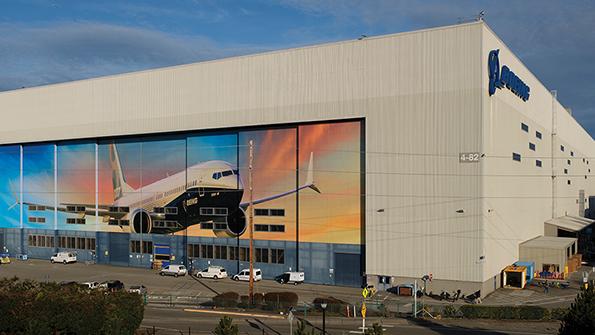4月成为波音有史以来最糟糕的一个月

四月对波音来说是最残酷的一个月。截至4月6日,美国宇航防务巨头华盛顿普吉特湾(Puget Sound)的场地因深度清洁而无限期关闭,继3月下旬至少有1人据报告死于COVID-19大流行后,波音试图说服工人返回工作岗位。同一天,该公司宣布其位于南卡罗来纳州查尔斯顿的工厂也暂停运营。
April is the cruelest month for Boeing. As of April 6, the aerospace and defense giant’s Puget Sound, Washington, sites were closed indefinitely for deep cleaning, and Boeing is trying to convince workers to come back after at least one local death from the COVID-19 pandemic was reported in late March. That same day, the company announced that work at its factory in Charleston, South Carolina, was suspended, too.
与此同时,波音询问是否有一些工人根本不想复工。
Meanwhile, Boeing is asking if there are some workers who do not want to come back at all.
4月2日,波音宣布自愿裁员,首席执行官兼总裁David Calhoun承认,其产品线可能会发生变化。尽管这些变化可能具有里程碑意义,但它们并不是最大的担忧。相反,OEM首先必须弄清楚如何在今年剩余的时间里为自己筹措资金。
On April 2, Boeing announced voluntary layoffs, and CEO and President David Calhoun acknowledged there likely will be changes coming to its product lines. But as monumental as those changes might be, they are not the biggest concern. Instead, the OEM first must figure out how to finance itself through the rest of the year.
随着美国国会接二连三通过其数万亿美元的刺激和救济法案,以应对冠状病毒大流行(CARES法案),该数字在3月受到广泛宣传。当波音为自身及其供应商寻求600亿美元的一揽子援助计划(其制定过程既草率又不透明)时,业界惊得下巴都掉下来了。
The numbers were well-publicized in March as the U.S. Congress raced to pass its multitrillion-dollar stimulus and relief bill in response to the coronavirus pandemic, the CARES Act. Jaws dropped when Boeing sought a $60 billion aid package for itself and its suppliers as part of the legislative sausage-making.
但我们很容易明白它为什么会这样做:因为经济衰退突然席卷了美国和全球,短期商业票据融资被冻结。波音首席财务官Greg Smith表示,至少暂时来说,融资渠道已经枯竭。Calhoun强颜欢笑地说波音可以获得150亿美元的现金和96亿美元的循环信贷额度。
But it is easy to see why it did so: Short-term commercial paper financing is frozen as a recession suddenly grips the U.S. and likely the world. Boeing Chief Financial Officer Greg Smith said access had dried up, at least temporarily. Calhoun tried to offer a brave face and said Boeing has access to $15 billion in cash and another $9.6 billion revolving credit line.
那么,波音为什么会寻求政府援助?截至2019年,该公司负债逾270亿美元,较上年翻了一番。到3月中旬,在信贷市场冻结之前,它已经新开随后又全面降低了一项总额近140亿美元的信贷额度。仅波音商用飞机每月就要耗费40多亿美元来为自己和一些供应商提供资金,首先是Spirit AeroSystems和通用电气航空,它还面临着其它巨额债务,比如42亿美元收购巴西航空工业公司大部分商业部门,以及40亿美元的债务偿还。分析人士表示,波音今年可能不得不再次将债务增加近一倍,特别是如果停飞的737Max由于COVID-19大流行造成继续停飞,直到今年年底才重新获准复飞。
So why would Boeing seek government aid? The company ended 2019 with more than $27 billion in debt, doubling the red ink from the year before. By mid-March, before credit markets froze, it had newly opened and then fully drawn down a credit line totaling nearly $14 billion. Boeing Commercial Airplanes alone is burning through more than $4 billion a month to bankroll itself and some suppliers, starting with Spirit AeroSystems and General Electric Aviation, and it faces other big bills such as the $4.2 billion acquisition of most of Embraer’s commercial division and $4 billion in debt repayments. Analysts say Boeing could have to nearly double its debt again this year, especially if the grounded and halted 737 MAX is not recertified until late this year due to further delays caused by the COVID-19 pandemic.
波音希望美国提供不附加任何条件的直接援助,或者由政府担保从其他金融机构那里获得贷款。Calhoun试图打消让美国政府在美国最大的出口企业和第二大国防企业中拥有完全股权的想法。
Boeing wants either no strings attached on direct U.S. aid or government guarantees that back its loans from other financiers. Calhoun tried swatting down the idea of giving Washington outright equity in what is the country’s biggest exporter and second-biggest defense prime.
但说起来容易,做起来难。“没有政府担保,波音没有太多的选择,”航空论坛的投资顾问Dhierin Bechai说,他的波音分析报告在Seeking Alpha上广受关注。商业航空的前景变得如此糟糕,以至于新造出来的客机要被运到仓库积压。即使商业信贷市场解冻到足以承担新债务的程度,波音也可能在债务条款上备受牵制。Bechai曾在3月31日说:“通过计算,你可以很快得出波音可以维持几个月的结论,但如果这将要持续到2020年底,那么公司将难以为继。”
But that is likely easier said than done. “There aren’t many options to explore for Boeing without a guarantee from the government,” says Dhierin Bechai, an investment advisor with the Aerospace Forum whose Boeing analyses are widely followed on Seeking Alpha. The commercial aviation outlook has turned so bad so rapidly that newly minted airliners are being flown to storage. Even if commercial credit markets thaw enough for new debt to be taken on, Boeing could get hammered on the terms of that debt. “Doing the math, you can conclude rather quickly that Boeing can sustain a couple of months, but if this is going to last well into late 2020, then this is not sustainable,” Bechai said March 31.
但能参与其中的工作可能较少。目前预计波音将在2020年或更长时间内保持新的、更低的生产率。
But there probably will be less work in which to be involved. Any day now, Boeing is expected to announce new, lower production rates for 2020 and perhaps for the longer term.
分析师们正在降低对未来产量的预期。垂直研究合作伙伴(Vertical Research Partners)的Rob Stallard和Karl Oehlschlaeger在3月30日表示,他们将未来五年的新客机需求预测修订为6300架,相较于之前预测的8300架。按机型,他们预计窄体机和宽体机将分别减少1540架和380架,与之前的需求模型相比,两者的降幅都约为25%。
Analysts are lowering their expectations for future production. Rob Stallard and Karl Oehlschlaeger of Vertical Research Partners on March 30 said they envision a revised requirement for 6,300 new airliners over the next five years, compared with their previous forecast of 8,300. By type, they foresee 1,540 fewer narrowbodies and 380 fewer widebodies, both roughly 25% cuts versus their prior demand model.
Jefferies的分析师Sheila Kahyaoglu和Greg Konrad在3月31日预测,2020年飞机交付量将同比下降约70%,他们将2020-2023年的累计交付量估计值降低约60%,因为航空公司继续推迟交付,大量宽体机队停飞。
Analysts Sheila Kahyaoglu and Greg Konrad of Jefferies on March 31 forecast that aircraft deliveries will fall about 70% year-over-year in 2020, and they reduced their 2020-23 cumulative delivery estimate by around 60%, as airlines continue to defer deliveries with a significant portion of the widebody fleet parked.
Jefferies这两位分析师认为波音今年将以平均每月4架的速度生产787宽体客机,2021年和2022年将增至6架。他们还预测777X的交付量为每月一架,“相对于每月三架的[的]假设,这是相当悲观的。”
The Jefferies duo assume Boeing will produce its 787 widebody at an average rate of four a month this year, stepping up to six in 2021 and 2022. They also forecast 777X deliveries at a rate of one per month, “which is quite pessimistic relative to [an] assumption of three a month.”
同样,罗兰·贝格(Roland Berger)的Manfred Hader和Robert Thomson也表示,考虑到MAX的情况,要恢复到2019年的整体生产率将需要两年时间,空客会较快恢复,而波音公司恢复时间会更长。
Similarly, Manfred Hader and Robert Thomson of Roland Berger say a recovery to overall 2019 production rates will take two years, albeit faster for Airbus and longer for Boeing, given the MAX situation.
在大型商用飞机需求方面,长期处于较低水平将是波音和空客的新常态。鉴于MAX已经落伍,波音可能会非常渴望任何美国人增加他或她在该公司的股份,甚至包括山姆大叔本人。
The new normal for Boeing (and Airbus) is lower for longer when it comes to large commercial aircraft demand. With the MAX already putting it behind, Boeing may become eager for any American to boost his or her stake in the company, even Uncle Sam.
这条消息是Michael Bruno在 Aviation Week & Space Technology 发表的文章。《Aviation Week & Space Technology》由人脉最广、经验最丰富的记者团队提供支持,为新趋势、最佳操作实践和政策、要求和预算的持续更新提供关键情报。 点击此处查看有关 Aviation Week & Space Technology 更多消息。